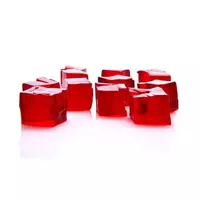Jelly

Remember the iron cremans on high legs in which ice cream was once sold in a cafe under the Soviet Union? Yes, yes, it was customary to serve in them and another favorite delicacy of children of that time - milk jelly. A snow-white dessert that just melted in its mouth and was always scarce. Nostalgia. . .
Currently, jelly has not lost its popularity not only due to its taste, but also beneficial properties. Interestingly, when you begin to be interested in the origin of the name of a product, it becomes obvious that most of them have French roots. So it happened with our dessert. French chefs used the word "gelee" when referring to a frozen dessert that consisted of a mixture of fruit juice (or syrup with water) as well as sugar and gelatin. There was also a second option - a frozen broth welded from animal bones - a well-known jelly or jelly.
By the way, you can make homemade jelly without gelatin, using agar-agar or pectin instead. At the time of the first mention of this product, the range of jelly did not differ in variety, but now they have not come up with any varieties of this rippling dessert. Fruit, coffee, dairy, tomato and even tea jelly!
Benefits of jelly
The benefits of jelly are concluded, first of all, in its composition. First, it is gelatin, which is an integral component of this tender dessert. It contains very important amino acids for our body, such as glycine, for example. This element is simply necessary when repairing damaged bones and boars. In addition, glycine is an excellent preventive agent against arthritis.
Another ingredient that chefs often use when making jelly is agar agar, a natural gelling substance that is extracted from brown and red algae. With it, the benefits of jelly will be relevant for vegetarians, although for meat adherents it can favorably affect the intestines, improving its peristalsis.
Pectin, which is also often used in the manufacture of jelly, has the ability to bind and remove heavy metal salts and radionuclides from the body. In addition, the calorie content of jelly is very insignificant, so it will not hurt anyone to treat yourself with a portion of this dessert.
Damage to jelly
The harm of jelly can only be mentioned when it is made of poor quality products. To do this, if you prefer to purchase ready-made dry mixtures in the store, carefully check the composition of the product, which must be present on the packaging.
jelly 87.6 kCal
Energy value of jelly (Ratio of proteins, fats, carbohydrates - ju):
Proteins: 2.8 g (~ 11 kCal)
Fats: 0.02 g (~ 0 kCal)
Carbohydrates: 20.3 g (~ 81 kCal)
Energy ratio (b | y): 13% | 0% | 93%
 Español
Español Français
Français Português
Português Русский
Русский 简体中文
简体中文 繁體中文
繁體中文 日本語
日本語 한국어
한국어 العربية
العربية Türkçe
Türkçe Қазақ
Қазақ Deutsch
Deutsch Italiano
Italiano Українська
Українська
